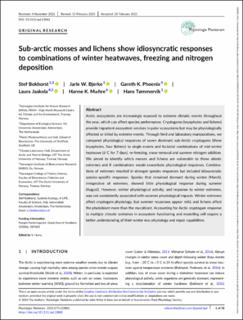| dc.contributor.author | Bokhorst, Stef | |
| dc.contributor.author | Bjerke, Jarle W. | |
| dc.contributor.author | Phoenix, Gareth K. | |
| dc.contributor.author | Jaakola, Laura | |
| dc.contributor.author | Mæhre, Hanne | |
| dc.contributor.author | Tømmervik, Hans | |
| dc.date.accessioned | 2023-04-04T10:24:03Z | |
| dc.date.available | 2023-04-04T10:24:03Z | |
| dc.date.created | 2023-02-27T13:31:47Z | |
| dc.date.issued | 2023-02-25 | |
| dc.identifier.citation | Bokhorst, S., Bjerke, J. W., Phoenix, G. K., Jaakola, L., Mæhre, H. K., & Tømmervik, H. (2023). Sub‐arctic mosses and lichens show idiosyncratic responses to combinations of winter heatwaves, freezing and nitrogen deposition. Physiologia Plantarum, 175(2). Portico. | en_US |
| dc.identifier.issn | 0031-9317 | |
| dc.identifier.uri | https://hdl.handle.net/11250/3062041 | |
| dc.description.abstract | Arctic ecosystems are increasingly exposed to extreme climatic events throughout the year, which can affect species performance. Cryptogams (bryophytes and lichens) provide important ecosystem services in polar ecosystems but may be physiologically affected or killed by extreme events. Through field and laboratory manipulations, we compared physiological responses of seven dominant sub-Arctic cryptogams (3 bryophytes, 4 lichens) to single events and factorial combinations of mid-winter heatwave (6°C for 7 days), re-freezing, snow removal and summer nitrogen addition. We aimed to identify which mosses and lichens are vulnerable to these abiotic extremes and if combinations would exacerbate physiological responses. Combinations of extremes resulted in stronger species responses but included idiosyncratic species-specific responses. Species that remained dormant during winter (March), irrespective of extremes, showed little physiological response during summer (August). However, winter physiological activity, and response to winter extremes, were not consistently associated with summer physiological impacts. Winter extremes affect cryptogam physiology, but summer responses appear mild, and lichens affect the photobiont more than the mycobiont. Accounting for Arctic cryptogam response to multiple climatic extremes in ecosystem functioning and modelling will require a better understanding of their winter eco-physiology and repair capabilities. | en_US |
| dc.language.iso | eng | en_US |
| dc.publisher | John Wiley & Sons Ltd on behalf of Scandinavian Plant Physiology Society | en_US |
| dc.rights | Attribution-NonCommercial-NoDerivatives 4.0 Internasjonal | * |
| dc.rights.uri | http://creativecommons.org/licenses/by-nc-nd/4.0/deed.no | * |
| dc.title | Sub-arctic mosses and lichens show idiosyncratic responses to combinations of winter heatwaves, freezing and nitrogen deposition | en_US |
| dc.title.alternative | Sub-arctic mosses and lichens show idiosyncratic responses to combinations of winter heatwaves, freezing and nitrogen deposition | en_US |
| dc.type | Peer reviewed | en_US |
| dc.type | Journal article | en_US |
| dc.description.version | publishedVersion | en_US |
| dc.rights.holder | © 2023 The Authors | en_US |
| dc.subject.nsi | VDP::Zoologiske og botaniske fag: 480 | en_US |
| dc.subject.nsi | VDP::Zoology and botany: 480 | en_US |
| dc.source.volume | 175 | en_US |
| dc.source.journal | Physiologia Plantarum : An International Journal for Plant Biology | en_US |
| dc.source.issue | 2 | en_US |
| dc.identifier.doi | 10.1111/ppl.13882 | |
| dc.identifier.cristin | 2129648 | |
| dc.relation.project | Norges forskningsråd: 225006 | en_US |
| dc.relation.project | Norges forskningsråd: 287402 | en_US |
| dc.source.articlenumber | e13882 | en_US |
| cristin.ispublished | true | |
| cristin.fulltext | original | |
| cristin.qualitycode | 1 | |

